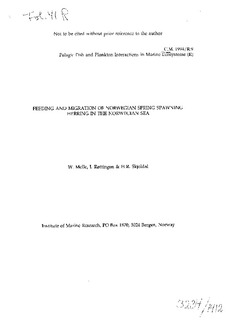| dc.description.abstract | After spawning on the shelf off Møre, Western Norway, the spawning stock of
Norwegian spring spawning herring migrates to the Norwegian Sea for feeding.
Simultaneously, the adolescent part of the stock leaves the wintering areas in
fjords and coastal areas of northern Norway and starts feeding in the Norwegian
Sea. During two cruises in April and June 1994, a transect from coastal water over
the Norwegian continental shelf across the frontal zone into Atlantic water in the
central Norwegian Sea was covered. Distribution and development of major prey
species of the herring, Calanus finmarchicus and C. hyperboreus, were described
in relation to hydrography and phytoplankton spring bloom dynamics.
In April, all year-classes of herring were found in Atlantic water where
zooplankton biomass was high in the upper 50 m of the water column. C.
finmarchicus occurred in the overwintering stages CV and adult females, and
feeding conditions were probably good. The older year-classes of herring showed a
westerly movement along the transect from April to June, and the oldest herring
were found farthest to the west. The herring did not cross the Polar front into
Arctic water masses in June, although feeding conditions, judged from
zooplankton biomass distributions, seemed far better than in Atlantic water. The
herring in June was distributed in Atlantic water masses with low biomass of
small stages of the new generation of C. finmarchicus, and feeding conditions
were probably not optimal.
The young year-classes of herring, which were found in Atlantic water in April,
occurred over the shelf in June. There the zooplankton biomass was
intermediate, but the new generation of C. finmarchicus had developed into late
copepodite stages and adults and served as potential large particle food items for
the herring. | no_NO |
